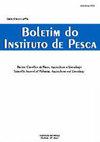柑桔精油对斗鱼的麻醉作用及急性毒性
IF 0.6
4区 农林科学
Q4 FISHERIES
引用次数: 0
摘要
本研究研究了柑橘精油(EOCS)在斗鱼(Betta splendens)中的应用,评估了其毒性、麻醉诱导和恢复时间、激动剂行为的作用以及对雄性集体转运的影响。以不同浓度的EOCS对鱼进行48 h的毒性处理,并进行诱导试验,评价不同浓度EOCS对鱼的镇静作用、麻醉作用和恢复情况。为了评估激动剂的行为,雄性受试者在暴露于未治疗的动物时,持续使用不同剂量的EOCS,评估眼部搏动和鳍扩张。在质量运输研究中,雄性被分为两个处理,具有两个水平的EOCS, 6小时,并在运输结束时分析鳃组织结构。结果表明,EOCS暴露48 h的平均致死浓度为49.17 μL·L−1。300 μL·L−1 EOCS时麻醉诱导时间最短。EOCS能减少雄性个体的激动剂行为。组织学分析显示,添加20 μL·L-1 EOCS后,鱼鳃丝高度降低。EOCS可作为一种镇静剂和麻醉剂。本文章由计算机程序翻译,如有差异,请以英文原文为准。
Anesthetic effect and acute toxicity of Citrus sinensis essential oil in betta
This study investigated the use of Citrus sinensis essential oil (EOCS) in Betta splendens, evaluating toxicity, induction and recovery times to anesthesia, its action on agonist behavior, and on male collective transport. To toxicity, fish were exposed to EOCS at different concentrations during 48 h. The induction test was performed to evaluate sedation, anesthesia, and recovery under different concentrations. To assess agonist behavior, male subjects were maintained with different dosages of EOCS, assessing opercular beat and fin expansion, while exposed to untreated animals. In the mass transport study, males were divided into two treatments with two levels of EOCS, for 6 h, also analyzing gill histometry at the end of transport. The results obtained show that the mean lethal concentration in 48 h of exposure to EOCS was calculated at 49.17 μL·L−1. The shortest anesthesia induction time was at 300 μL·L−1 EOCS. EOCS was able to reduce agonist behavior in males individual. Histometric analyzes revealed a reduction in the height of gill filaments in fish transported with 20 μL·L-1 EOCS. EOCS can be used as a sedative and anesthetic agent for B. splendens.
求助全文
通过发布文献求助,成功后即可免费获取论文全文。
去求助
来源期刊

Boletim do Instituto de Pesca
FISHERIES-ZOOLOGY
CiteScore
0.80
自引率
0.00%
发文量
24
审稿时长
>12 weeks
期刊介绍:
To publish original articles of research and short communications in the following áreas: Fisheries, Aquaculture, Zootechnology, Limnology, Oceanography, Biology and Pathology of aquatic organisms. The publication depends on the approval of the Editorial Board, based on the peer review.
 求助内容:
求助内容: 应助结果提醒方式:
应助结果提醒方式:


